Products You May Like
Get access to everything we publish when you
sign up for Outside+.
Finding the perfect pair of running shoes is a seriously personal affair. Every runner’s feet, gait, leg length, hip angles, weight, speed, and ride-feel preferences are different. So while we can’t tell you the single best shoe, we can steer you toward models that impressed us with their comfort, support, and ride, and tell you where they excel.
Don’t miss: The Best Trail-Running Shoes of 2023
How We Test
Number of testers: 25
Number of shoes tested: 49
Number of miles: 2000+
To test running shoes, we begin by researching every brand’s upcoming offerings for the season. We wind up with samples of the models that are most promising—not just for us, but for 25 testers that range in age, ability, running form, geographical location, terrain, and preferred shoe types. We try to put each tester in models from within the same category (all cushioned, long run trainers, or all road racing shoes) so everyone can test apples-to-apples.
[sidebar cta_link=”https://shop.outsideonline.com/pages/gear-up-give-back” cta_text=”Print Your Free Label” hed=”Free Gear Upcycling”]When it’s time to upgrade your gear, don’t let the old stuff go to waste–donate it for a good cause and divert it from the landfill. Outside’s partner, Gear Fix, will repair and resell your stuff for free! Just box up your retired items, print a free shipping label, and send them off. We’ll donate 100 percent of the proceeds to The Outdoorist Oath.[/sidebar]
After three months of running in each model on varied terrain and in all conditions, our crew members report back with their assessments of fit, comfort, traction, cushioning, flexibility, stiffness, pop, what type of running the model is best used for, how the shoe compares to other models, and more. We also run in every shoe ourselves, and, combining all the tester feedback with years of personal experience, hone in on the best.
Meet Our Lead Testers
Cory Smith
Cory’s passion for running started over 25 years ago in high school when he became the number six ranked runner in the nation in the 3km his senior year. Ever since then, Cory’s been addicted to competitive running in every distance, from one mile to the marathon on the track, roads, and trails. His obsession with running shoes started in 2014 when he wrote his first shoe review. Since then, he’s tested and reviewed hundreds of running shoes, clothing, and gear for Outside and other outlets. He loves dissecting gear and thinking like a product engineer to explain the why behind every design and little detail of running shoes. Today, he’s an online running coach in addition to reviewing running gear.
Lisa Jhung
Boulder, Colorado-based journalist, editor, and author Lisa Jhung has researched, tested, and written about running shoes for the past decade and a half and regularly writes about running, other endurance sports, and anything adventure-related. She’s been an editor at Trail Runner Magazine, a contributing editor to Runner’s World, co-founded the now defunct Adventure Sports Magazine (2002-2005), and freelances as an editor, copywriter, and journalist. She’s the author of “Running That Doesn’t Suck: How to Love Running (Even If You Think You Hate It)” (2019) and “Trailhead: The Dirt on All Things Trail Running” (2015). In previous lives, she was an adventure racer, triathlete, and off-road triathlete. She now mostly runs in the mountains for reasonable Type II fun.
Reviews: The Best Road-Running Shoes of 2023
Asics Magic Speed 2 ($150)
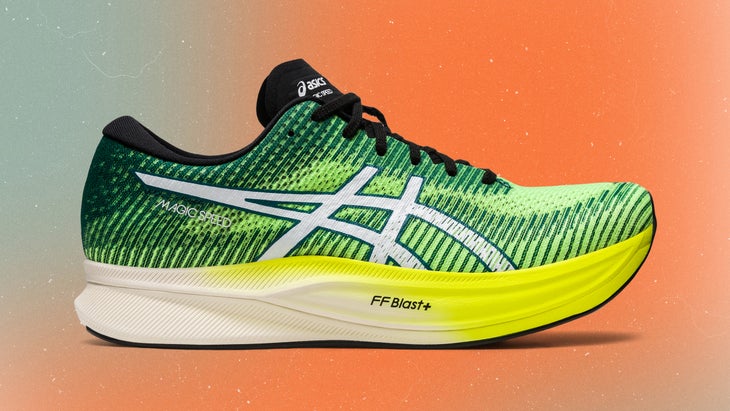
Weight: 8.3 oz (men’s) / 6.9 oz (women’s)
Stack Height: Men’s 31 – 24 mm / Women’s 30 – 23 mm
Drop: 7 mm
Best: Combination of Fast and Stable
Strengths:
- Carbon/TPU-blend plate adds pop and stability, with flex
- Affordable price for performance
Weaknesses:
- Firmer, stiffer and faster-tuned than some want in a trainer
The Asics Magic Speed 2 magically turns regular runners into superheroes, or at least makes them feel that way. “You can’t help but clip along nicely in this shoe,” said one tester. The speedy ride stems from a lightweight package that includes an aggressive toe rocker, soft yet highly-responsive EVA-based foam, and an embedded curved plate made of a blend of carbon fiber and TPU.
In contrast to the rigid, pure-carbon plates found in top-end marathon-racing supershoes—which can feel too propulsive and prescriptive for less–than-elite strides and paces—Asics’ carbon-TPU blend is more flexible, yielding a versatile tool for anything from daily runs to tempo workouts, 5Ks to marathons. While version one of the Magic Speed had a partial-length plate, version two’s is full-length, adding some stability to the quick-rolling ride.
That new plate is just one of many significant improvements from the earlier iteration of this shoe, which ran more like a racing flat. Version two is also cushier, thanks to two different layers of springy foam sandwiched on either side of the plate—a softer foam above it, and a firmer one below (next to the outsole). We found the combination felt noticeably softer than the single, two-millimeter thinner layer used in version one. The fit of the engineered mesh upper is a bit more foot-hugging and secure than the first—a boon for those with narrow feet, though those with high-volume feet may find it snug. And don’t let the thin outsole fool you; it’s made from a proprietary grippy-rubber compound that tested highly for traction on pavement and concrete.
Even with the changes, however, this is still one of the firmer, stiffer, faster-tuned models in the semi-super shoe trainer category. Nutshell: the Magic Speed 2 is best for days when you’re rested and ready to levitate, be that in a race or on speedy training days. Consider this your cape, superheroes.
Altra Vanish Tempo ($190)
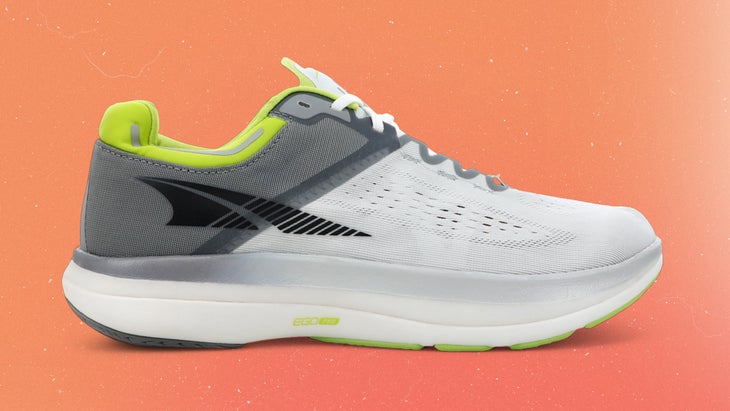
Weight: 8.2 oz (men’s) / 6.9 oz (women’s)
Stack Height: 33 – 33 mm
Drop: Zero
Best: For balanced bounce
Strengths:
- Super-foam bounce in a versatile, everyday training shoe
- Best-in-class cushioning to weight ratio
Weaknesses:
- Pricey for a non-carbon-plated shoe
- Too narrow for those accustomed to Altra’s traditional shape
The Vanish Tempo is strikingly similar to its carbon-plated supershoe sibling, the Altra Vanish Carbon. Both models share the same 33-millimeter stack height, Altra’s lively, nitrogen-infused midsole foam, and an aggressive early rocker. They’re both zero-drop, and both have the same simple, flexible upper. But the Tempo lacks a plate in its bouncy midsole, making its ride a little softer and more forgiving, if not quite as snappy and propulsive. Testers reported that the plateless midsole delivers a plush and lively feeling regardless of the pace or stride. The foam is supportive enough to transition smoothly from heel to toe, and tester Brock Butler pointed out that the early rocker makes it “easy to shift to the forefoot as the pace increases.”
All our testers loved how the breathable engineered mesh upper provided superb midfoot lockdown, but they had mixed feelings about what Altra is calling its new “Slim Footshape Fit,” a departure from the signature exaggerated wide toe box Altra is famous for. Those who already appreciate the brand found the slim toe box a little narrow for their liking, but those used to other brands welcomed the more mainstream narrow-fitting upper.
Despite the “Tempo” namesake, testers unanimously agreed that this isn’t just a fast-day shoe. It’s equally suited for endurance and recovery runs: our testers wanted to run in it every day. Even our zero-drop shoe critics enjoyed the smooth, cushioned ride (perhaps because the soft foam and early rocker make it feel like the sole has a moderate heel-toe drop).
On Cloudmonster ($170)
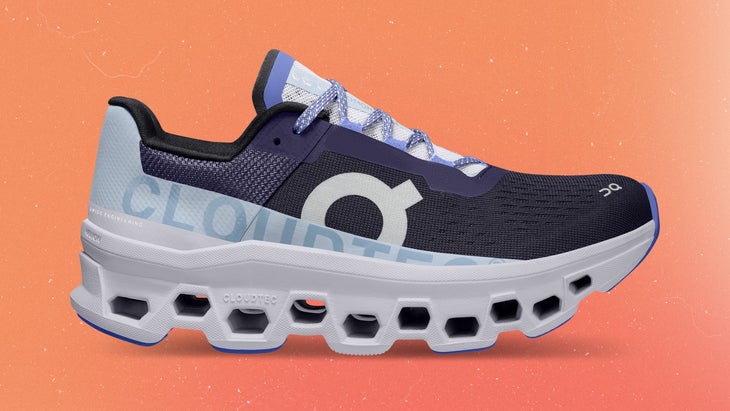
Weight: 9.7 oz (men’s) / 8.1 oz (women’s)
Stack Heights: 33 – 27 mm
Drop: 6 mm
Best: Max-Cushion Trainer
Strengths
- Custom cushioning with a stable, smooth-rolling platform
- Super-comfortable upper
Weaknesses:
- Not as soft as other premium cushioned shoes
All shoes from On feature funky, open pods underfoot that compress, then rebound, balancing cushioning with a stable, responsive platform. On calls them clouds. Though we’ve enjoyed running in some of those models, many tend to feel a tad hard. The Cloudmonster is different: more light, fluffy cumulus than flat, static stratus.
Its midsole cushioning comes from ten rows of massive, hexagonal pods—the largest on any On shoe to date—which allow the brand’s resilient foam to compress upon impact for a cushy ride. Yet the ride is surprisingly stable and lively as well. Testers called the shoe “fun” and “bouncy” to run in. The deep channel running down the center of the midsole from the heel to the midfoot isolates each pod’s action, creating an almost custom cushioning platform based on how your foot hits the ground, while above the pods, a full-length, slightly-helix-shaped, flexible and responsive polypropylene plate delivers a smooth transition from heel strike to the peppy toe-off.
This is a comfortable shoe overall, with a roomy, soft and breathable upper, a flat, integrated tongue made of thin, perforated mesh, and lace loops securing the foot in a soft, even hug. We like the Cloudmonster for long runs, recovery runs, or just anytime we’re craving a little extra soft bounce.
New Balance SuperComp Trainer ($180)
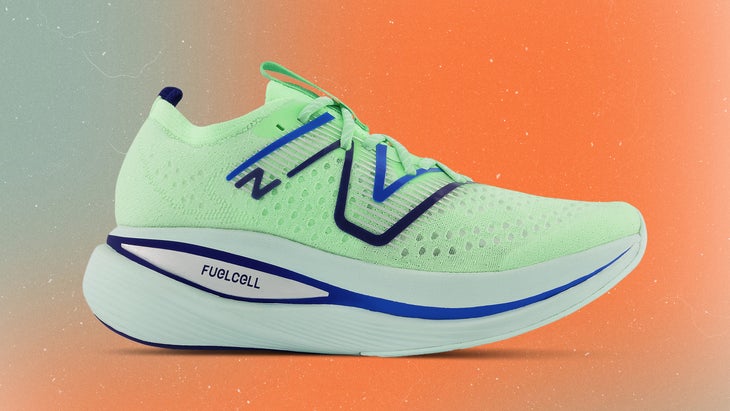
Best for Peppy Runs
Weight: 10.7 oz (men’s) / 9.3 oz women’s
Stack Height: 43.5 – 35.5 mm
Drop: 8 mm
Best: For peppy runs
Strengths:
- Super-peppy, bouncy ride
- Feels lightweight and lively for highly-cushioned shoe
Weaknesses:
- Huge stack height can feel unstable on anything but super-smooth terrain
- Seam on ankle collar rubs some runners wrong
The SuperComp Trainer is the kind of shoe that makes you want to run for longer than intended. From the moment we put it on, we were saying “boing, boing, boing” in our heads with every step. Just like that, a three-mile easy run turned into a five-mile jaunt, with the last two miles uptempo. (Maybe not a good thing for those following a training plan).
Contributing to that lively ride is a thicker-than-race-legal layer of nitrogen-infused FuelCell foam that’s plenty responsive on its own. But that foam is bolstered by a full-length, arched carbon plate surrounded by strategically placed open spaces to maximize propulsion. The theory is that the plate flattens into the voided space under the weight of a running step, and then rebounds, trampoline-style, with more energy than plates surrounded completely by foam. While the “more” is hard to quantify, the rebound is no joke. “You are definitely propelled forward easily as you move off the front of your foot,” said tester Kiki Silver.
Meanwhile, a thin, stretchy, single-layer knit mesh upper with a minimal sock-like tongue breathes well and conforms around the foot. The knit mesh holds its shape thanks to thin, lightweight TPU film overlays. A couple of testers complained about the interior seam of the ankle collar of the shoe digging into their skin, but we think that might vary anatomically per runner (so, try them on). For runners who didn’t feel the rub, these shoes quickly earned a spot in the rotation for long runs, fast track or road workouts, and races up to half-marathon or even marathon distance (unless you have a chance at the podium, where they could get you disqualified).
Adidas Adizero Adios Pro 3 ($250)
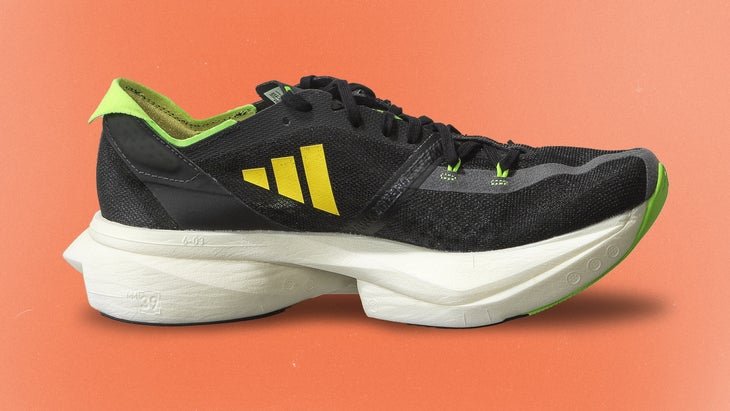
Weight: 8.1 oz (unisex)
Stack Height: 39.5 – 33 mm
Drop: 6.5 mm
Best: For stable, speedy marathoners
Strengths:
- Best stability of all carbon fiber super shoes
- Outstanding traction, especially in wet conditions
Weaknesses:
- TPU midsole not quite as bouncy as Pebax super foams
- Scratchy upper
In 2021, 60 percent of the World Major Marathons were won wearing the adidas Adizero Adios Pro 2; making it clear there’s something special going on with this shoe. Looking to build on that successful pedigree, Adidas gave the Adizero Adios Pro 3 some sizeable upgrades that make it a more cushioned, stable, and accessible marathon supershoe.
The enhanced ride comes from a wider base, an additional two millimeters of foam under the forefoot, and a more rigid, full-length version of the brand’s proprietary carbon-fiber plate (a series of rods, which now join at the heel before spreading out under the forefoot metatarsals). The foam in question is a TPU-based material that feels similar to the foam used in their game-changing Boost models, but is far lighter. The resulting midsole is thick, cushioned, and responsive—though not quite as bouncy as the trampoline-like Pebax used in many supershoes. But testers all agreed that the Adios Pro 3 makes up for it with a smooth-rolling ride that only gets better at quick paces. (Credit a steep, forward-leaning toe rocker.) And, though the shoe felt stiff initially, testers said the ride softened and came alive after a few break-in miles.
Testers also enjoyed the airy textile mesh upper, calling out its high degree of breathability. Fit is true-to-size, with enough room in the toe box to allow for a natural toe splay over the wide sole.
For those looking for a surprisingly stable, supportive super-shoe racer that’s still plenty bouncy, the adidas Adizero Adios Pro 3 might just be the ticket to your next marathon PR.
Saucony Endorphin Speed 3 ($170)
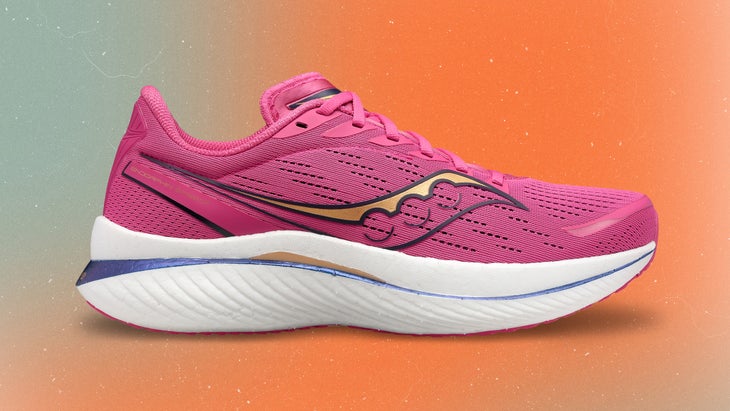
Weight: 8.1 oz (men’s) / 7.2 oz (women’s)
Stack Height: 36 – 28 mm
Drop: 8 mm
Best: For uptempo training
Strengths:
- Propulsive, stable, flexible and one of the bounciest shoes we’ve tested
- Excellent price-to-performance ratio
Weaknesses:
- Annoying road-slapping noise
While high-end carbon fiber racing shoes get all the attention, an equally exciting class of shoes lurks in their shadows: the semi-super shoe. This category of fast training and racing kicks make high-performing materials and tech more accessible to the everyday runner in price and ride. No other shoe exemplifies the qualities of semi-super shoes better than the all-new Saucony Endorphin Speed 3.
“These shoes are bouncy as hell,” one tester excitedly noted about the thick stack of PEBA (polyether block amide)-based PWRRUN PB midsole underfoot. That’s the same foam found in Saucony’s higher-end racing shoe, the Endorphin Pro 3. But instead of a carbon plate, the Endorphin Speed 3 boasts an embedded S-curve nylon plate. This adds stability to the soft but responsive midsole while gently guiding your foot toward a slightly-flexible forefoot take-off that feels smooth and propulsive at any pace. Saucony enhanced the Speed’s stability in this version by widening the midsole, especially under the arch, and giving the nylon plate wings that extend out from the sides at the midfoot. At the heel, a firm piece of plastic runs strategically up the outside, providing unintrusive rearfoot support.
Testers appreciated the changes, reporting that the Endorphin Speed 3 showed incredible poise at all paces, from leisurely warm ups to demanding tempo runs, even during the exhausted shuffle of a cooldown. They also praised the smooth wrap of the engineered mesh upper and thin, gusseted tongue, plus the secure, comfortable hold of the elastic laces.
Aside from the loud slapping noise of each ground strike, the test team struggled to find a noticeable flaw. The Saucony Endorphin Speed 3 offers supershoe powers at a fraction of the price that will make any runner scream, like one tester, “I can and want to run fast!”
Brooks Glycerin GTS 20 ($160)
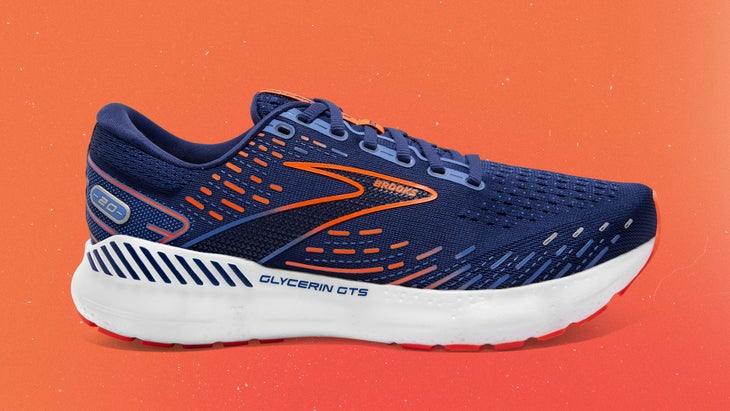
Weight: 10.5 oz (men’s) / 9.4 oz (women’s)
Stack Height: 38 – 28 mm
Drop: 10 mm
Best: For stable cushioning
Strengths:
- Exceptional midsole cushioning has noticeable bounce-back
- Stable for pronators, while no less smooth-riding than neutral shoes
Weaknesses:
- Not a speedy ride
- Drop feels high for some
We loved last year’s hard-to-get, limited edition Aurora BL that came from Brooks’ BlueLine innovation lab, mostly because of its midsole feel. So we’re thrilled to see that same cushioning compound—DNA Loft v3, a blend of EVA, air, and nitrogen gas—show up in this franchise shoe. The cush is soft but resilient—testers could actually feel the bounce-back—and crazy lightweight. To have that kind of comfort and pop in a stability shoe is rare. One tester who needs guidance through her gait felt like she had hit the jackpot.
There’s no clunk to this smooth-rider, with stability coming from firm TPU strips (Brooks calls them guiderails) along both sides of the rearfoot atop the dreamy foam base. They’re unobtrusive when you don’t need them, but gently impactful when you do. The midsole and outsole are redesigned to give runners more room throughout the midfoot, which produces a smoother and more stable transition from heel strike to toe-off. The stretchy and secure engineered mesh upper and soft, padded tongue add to the joys of this comfy workhorse. For runners wanting a stable shoe that doesn’t sacrifice ride, here’s your new go-to.
How to Buy Road-Running Shoes
All the shoes in this round-up made the cut because they’re solid performers. So how do you choose the right pair for you? First, consider what kind of running you do: mostly road, or mostly trail? (And, we hate to break it to your bank account, but if you do both, you’ll need both.)
If you’re looking for a road shoe, do you want a speedster or something that feels good on long, slow jogs? If you train and race, and want to maximize your racing efforts: again, you might need both. Do you like the feel of a soft, forgiving ride, a more bouncy, energetic sensation underfoot, or a firmer platform that provides more groundfeel? The primary differences between various road shoes boil down to the foam material, volume and geometry of the midsole, which has the biggest influence on how a shoe feels on the run.
If you’re looking for trail shoes, do you run rugged, mountainous terrain, or mellow dirt paths? Some trail shoes can handle both adequately, while others are specialized and excel in one or the other. Shoes with smaller lugs are generally better on less technical terrain, whereas shoes with deeper, more aggressive outsoles are optimized for steep, rocky, or muddy trails. Do you like to feel the trail and pick your way around rocks and roots, or would you rather let the shoe cushion and protect you from trail variations while you zone out? Your answer here will determine whether you should look for a shoe with a minimal or maximal midsole.
Deciding what you’re looking for is a big first step. From there, you’ll want to go to a store and try on a few different shoes from within the niche you’ve chosen. Lace up. Run a few steps. Run a few more. Do they fit your foot shape, holding your heel and instep securely while letting your toes move naturally—without binding or rubbing anywhere? Do you land softly and comfortably? Do you feel stable and smooth as you roll through your stride, the shoe so in sync with your feet that you forget they’re there? Do you feel protected, supported and connected to the ground? Do the shoes make you want to run? If you can answer yes to all of those questions, you’ve found your pair.
